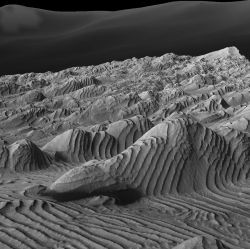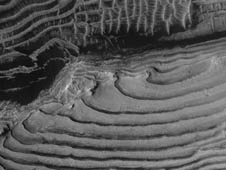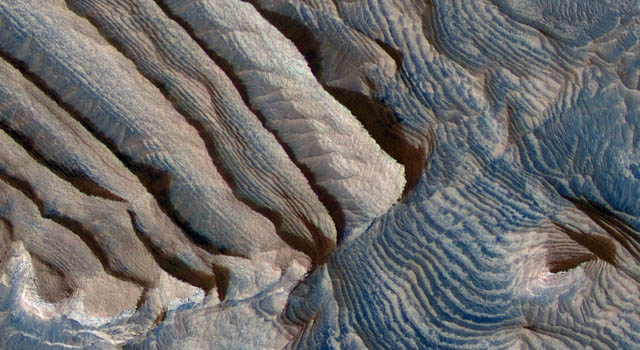[/caption]
We see evidence on Mars’ surface of a violent past: massive volcanic eruptions, catastrophic floods, and a surface scarred with craters. But new images of rock formations on Mars resembling stairs suggest Mars at one time had a regular pattern of predictable and even moderate climate cycles persisting for millions of years. Three-dimensional images from the HiRISE camera on the Mars Reconnaissance Orbiter show patterns in thick stacks of sedimentary rock layers, formed by a cyclical climate that is likely tied to the wobble of Mars on its axis.
Combining several images of the rock formations from different perspectives, scientists were able to produce three dimensional images, as well as a dramatic flyby movie of the layered sediments. Based on a pattern of layers within layers found at an area called Becquerel crater, the scientists propose that each layer was formed over a period of about 100,000 years and that these layers were produced by cyclical climate changes. The outcrops have been eroded into mounds on the floors of the craters, with many of the layered deposits showing a stair-stepped shape. Each layer has exactly the same thickness.

Every 10 of the “staircase” layers are bundled into a larger unit, which the team, led by Kevin Lewis of the California Institute of Technology, calculates was laid down over a million-year period, and Becquerel contains 10 of these bundles. One million years is the same duration as the periodic variations in Mars’ tilt, suggesting that climate variations induced by the tilt produced the layering. Each bundle, then, represents climate processes as the planet tilted. This tilt periodically cooled the equatorial region and warmed the poles as they received more sunlight.
“Due to the scale of the layers, small variations in Mars’s orbit are the best candidate for the implied climate changes,” said Kevin Lewis of the California Institute of Technology, who led the study. “These are the very same changes that have been shown to set the pacing of ice ages on the Earth and can also lead to cyclic layering of sediments.”

The tilt of Earth on its axis varies between 22.1 and 24.5 degrees over a 41,000-year period. The tilt itself is responsible for seasonal variation in climate, because the portion of the Earth that is tipped toward the sun–and that receives more sunlight hours during a day–gradually changes throughout the year. During phases of lower obliquity, polar regions are less subject to seasonal variations, leading to periods of glaciation.
Mars’s tilt varies by tens of degrees over a 100,000-year cycle, producing even more dramatic variation. When the obliquity is low, the poles are the coldest places on the planet, while the sun is located near the equator all the time. This could cause volatiles in the atmosphere, like water and carbon dioxide, to migrate poleward, where they’d be locked up as ice.
“It’s easy to be fooled without knowing the topography and measuring the layers in three dimensions,” said Alfred McEwen of the University of Arizona, Tucson, principal investigator for the camera and a co-author of the paper. “With the stereo information, it is clear there’s a repeating pattern to these layers.”
Sources: JPL, Caltech


Before or after Phobos and Deimos?
So if I read correctly each ripple is basically a one hundred thousand years old and ten such ripples make a mound which then make the mound equal to a million years old.
My question is in a field of mounds where do they know where the process starts or began taking form.
This looks like a hell of a place to actually walk around. When are they giving tourist visas?
Google Mars 2.0, anyone?
I was wondering whether there is any sort of magnetic variations also observed in these layers which can give an idea abt the effect of tilt on magnetic field….Just a random thought…can anyone comment on it, plz?
Where are all you scientist that comment on here? This stuff is real puzzling!!! So much different than other areas of Mars.
Maybe not the best place to start whining, but why do most of the pictures that accompany the articles on this site are so small, or never can be enlarged to see any detail? I’m sure NASA takes them in greater resolution than what’s published here.
Thanks a lot for your wonderful coverage. However, this provides an ample explanation for the periodicity of the process, but no hint so far on the process itself, that led to the formation of the layers. On our planet, the stratified rock appears either as the result of solid particles sedimentation in aquatic conditions (e.g. marine and lacustrine sediments) or in case of subaerial accumulation by constant sand/silt laden winds blowing over very extended periods of time in the same direction (e.g. loess plateau in China). Is there any discussion on the origins of the the stratified rock on Mars?